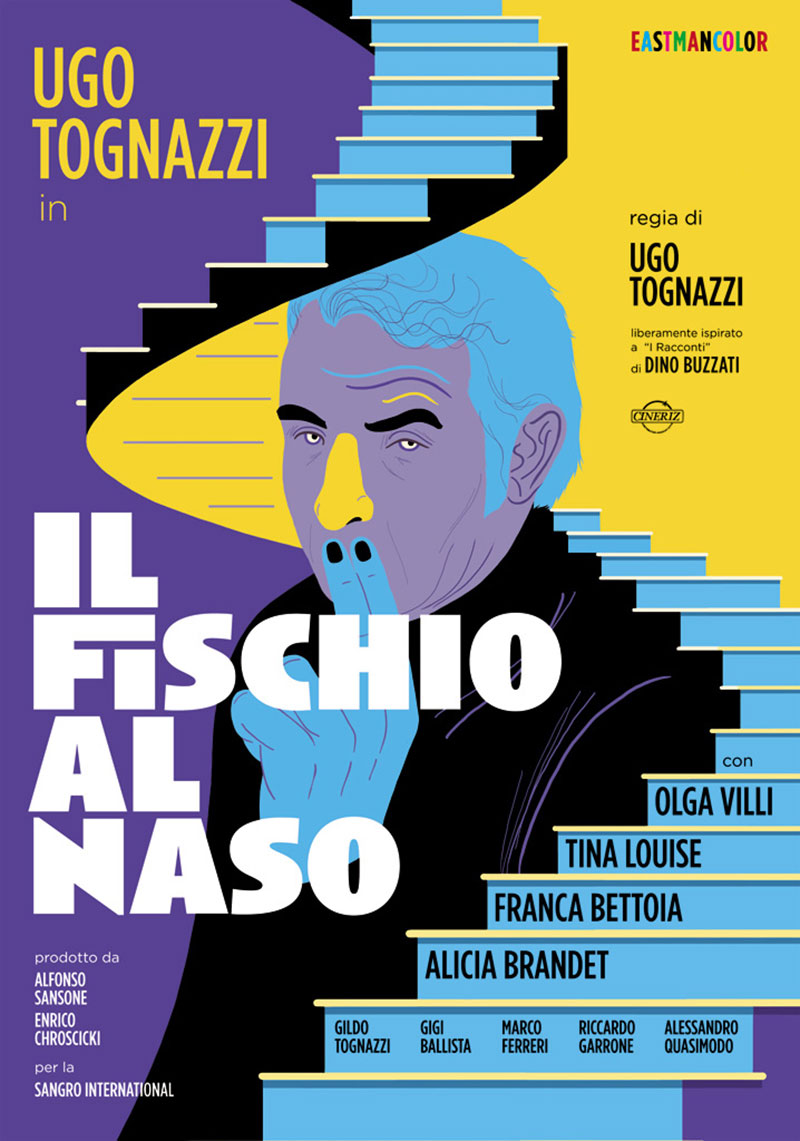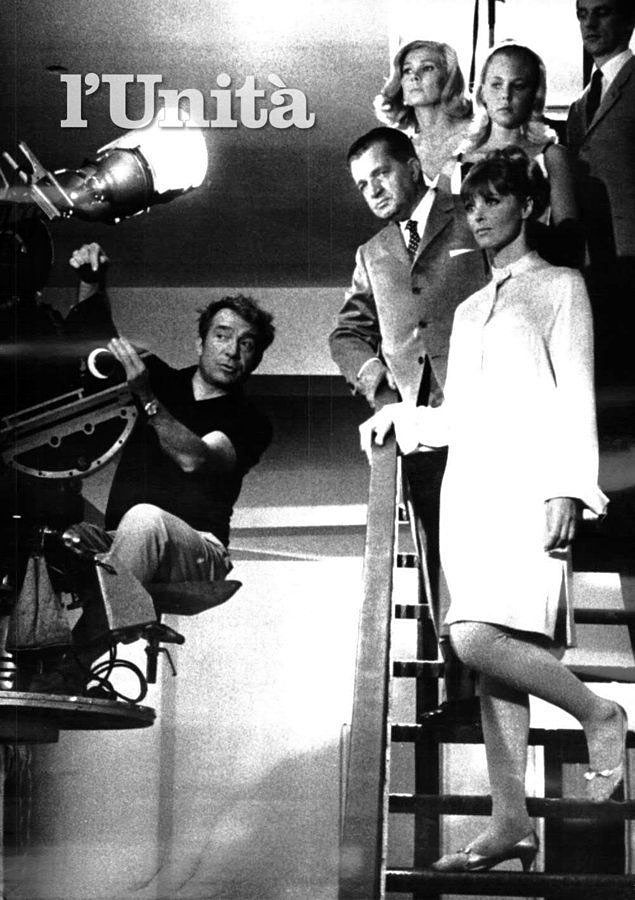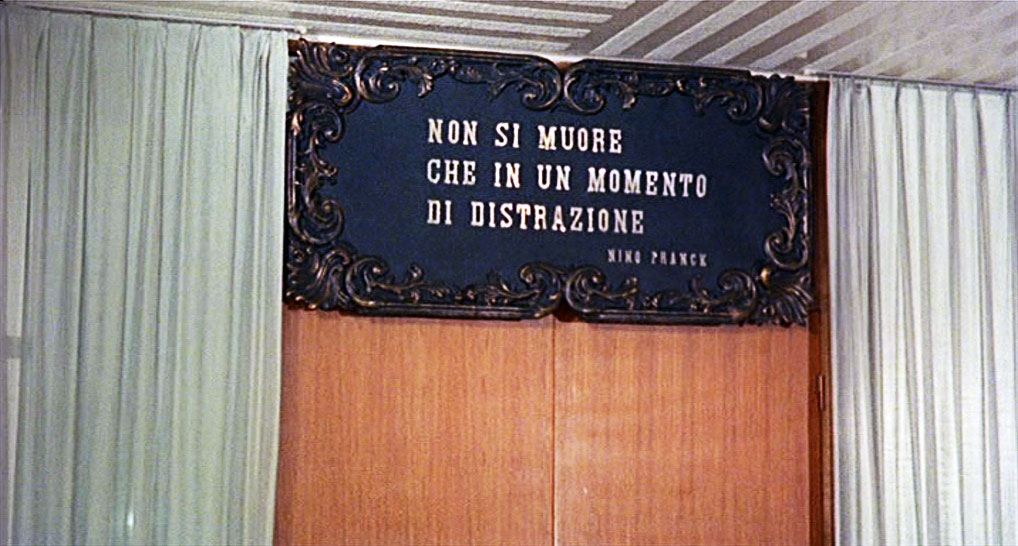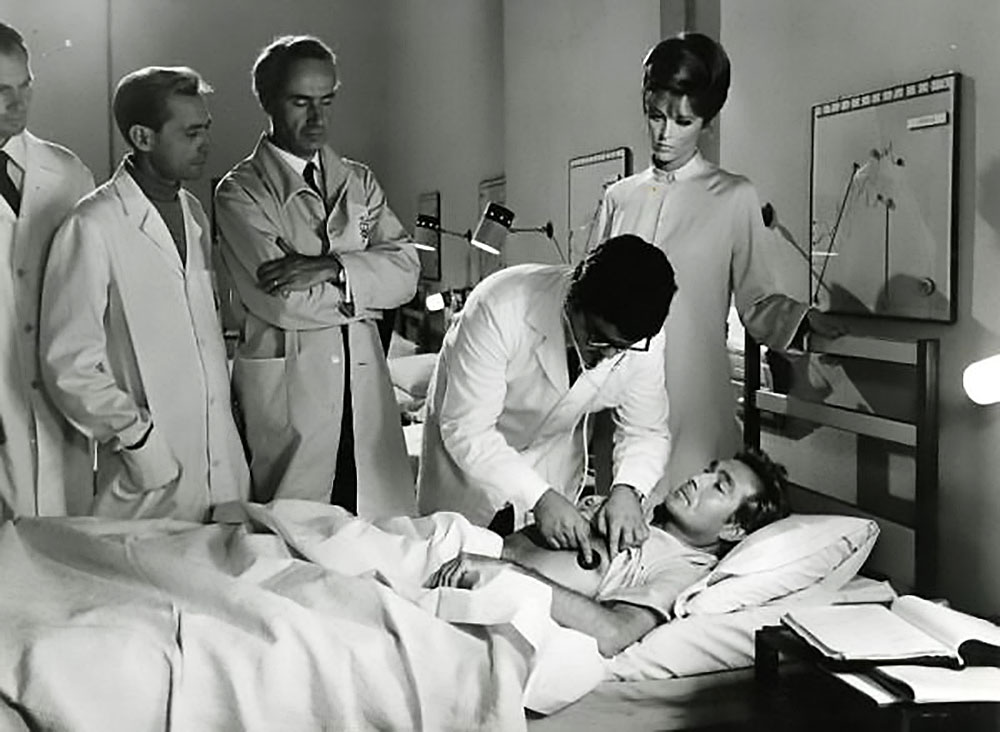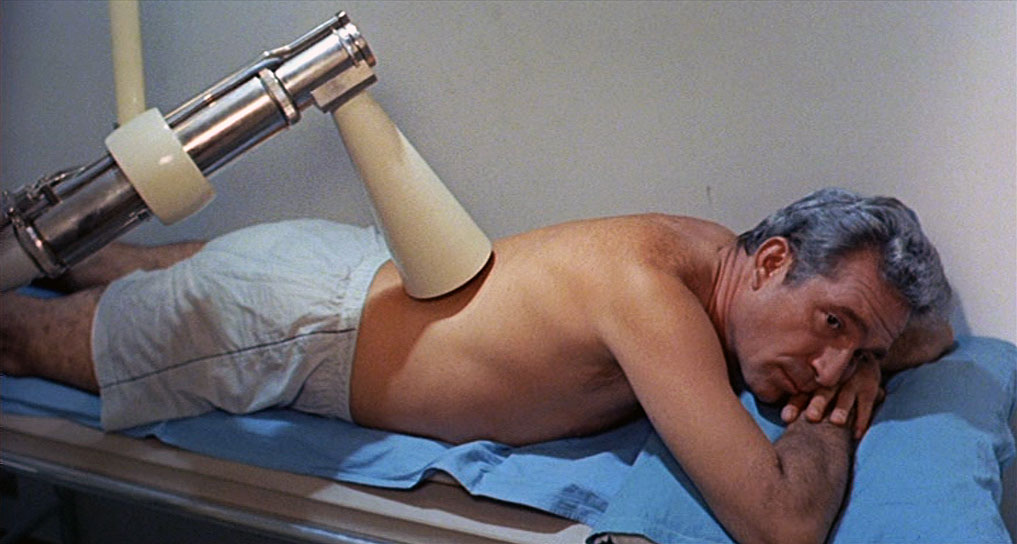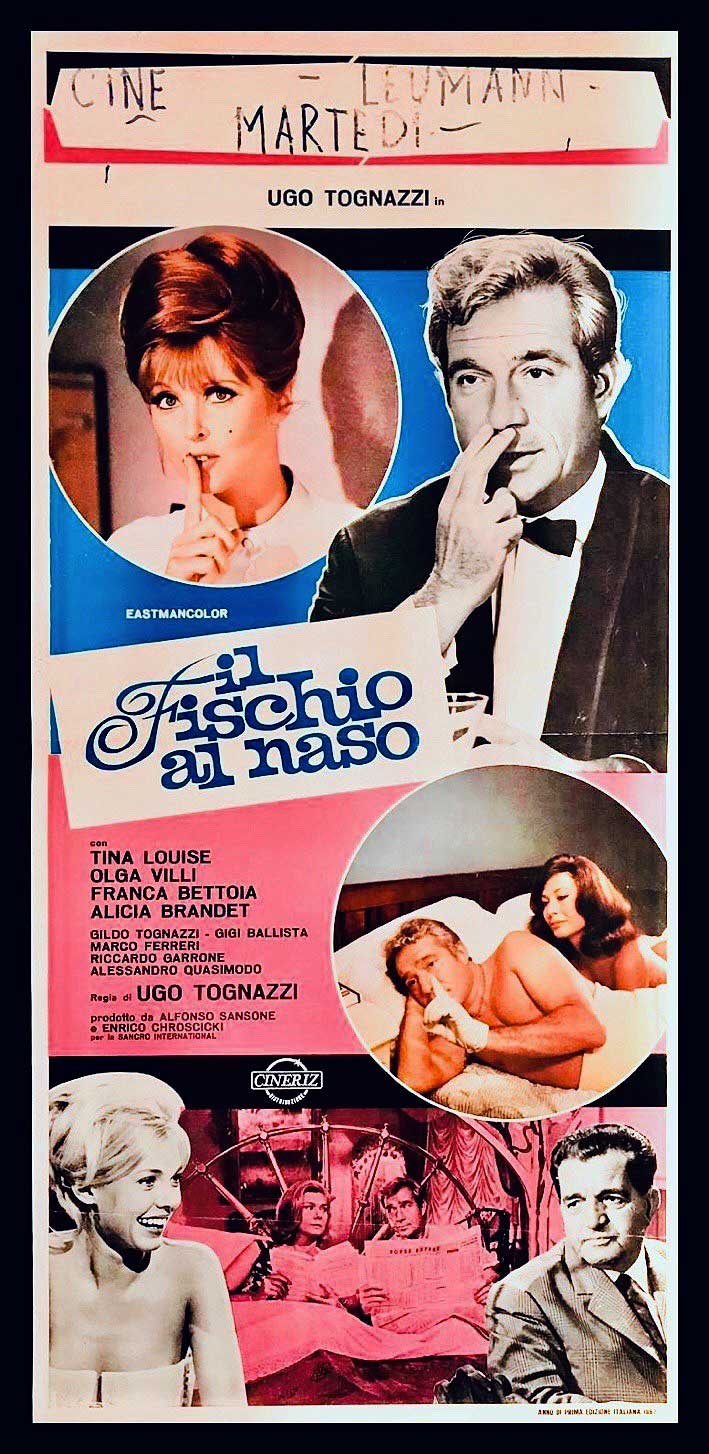”Based on a short story by Dino Buzzati, in his second movie direction Ugo Tognazzi builds up a harsh satire on how the healthcare industry manages to create sick people from perfectly healthy ones.
Lorenzo
Article by Daniele Pieraccini
(spoiler alert)
“Con la descrizione di questa industria della malattia, ho voluto rendere la degenerazione che porta la società dei consumi anche nella scienza, cioè in quella parte della società che dovrebbe invece conservare l’uomo, la sua integrità fisica e psicologica”
(Ugo Tognazzi, dal libro a lui dedicato nel 1981 da Claudio G. Fava e Aldo Bernardini).
The film is tastefully vintage (with typically Space Age furnishing accessories such as Brionvega televisions and Artemide lamps), but the story narrated, dystopian and Kafkaesque, could not be more current.
Tognazzi, in his second work as a director, elaborates a clear critique of a world adrift, without ideals or morals, in which what matters is to produce and consume and then be ruthlessly consigned to death, after a life devoid of any authentic meaning.
Concepts that he will reiterate in the “Loganian” I viaggiatori della sera (1979), his last dystopian movie (which could also have found a valid cantor in Elio Petri) based on the novel of the same name by Umberto Simonetta.
The Seventh Floor (Il fischio al naso) is instead inspired by a short story by Dino Buzzati, The seventh floor (I Sette piani), published for the first time in 1937 then revised and included, after various reworkings, in at least three collections.
Buzzati also elaborated a theatrical transposition, A clinical case (Un caso clinico), in 1953.
It can be deduced that certain themes (the healthy, or the today’s asymptomatic who becomes a slave and then a victim of health care) have inspired certain authors who were particularly attentive and aware already in the last century, up to today’s reality made up no longer of care and assistance centers but of real health companies. Think also of Knock ou Le triomphe de la médecine (Knock or the triumph of medicine), a play by Jules Romains from 1923, broadcasted on television on RAI in the same year as Tognazzi’s film.
«Mi dica, dottore, come va il processo distruttivo delle mie cellule?»
In Buzzati’s story, a lawyer named Giuseppe Corte (strangely very similar to the name of the ex “Italian premier”) disturbed by a very slight uneasiness not specified, is admitted to a modern clinic specializing precisely in the treatment of the rare disease that afflicts him.
The sanatorium is divided into seven different floors: patients with lighter forms are hospitalized in the higher one; as the severity of the case increases, the floor gradually descends, up to the first floor which houses hospitalized patients with no more hope.
What looks like a short-term hospitalization in a comfortable and reassuring environment, with the return home planned at the end of a series of exams, turns out to be a real descent into hell.
While Giuseppe Corte’s health worsens rather than improves, a chain of inconveniences (administrative oversights, employee holidays, a doctor’s fussiness) causes him to be detained and gradually transferred to the lower floors, despite his protests, however blocked by the continuous reassurances of the doctors on the non-seriousness of his case. In a crescendo of helplessness, sadness and resignation, the lawyer will sadly find the end of his days interned on the first floor.
In the movie Tognazzi, assisted in the screenplay by the trusted duo Scarnicci-Tarabusa, by Rafael Azcona, novelist and close collaborator of Marco Ferreri and the well-known sports commentator Alfredo Pigna, sets up an operation that is even more directly to the target and far from any metaphorical spirit.
“produrre, consumare, gettare via!”
The protagonist, masterfully played by Tognazzi himself, is called Giuseppe Inzerna and is a successful entrepreneur in the paper industry.
His motto is, as he repeats several times, “consume and destroy”. Even the recurring musical theme, ‘La conta‘, a beat song by Le Pecore Nere, obsessively recalls for the entire duration of the film that “today it’s my turn, tomorrow it’s you”, underlining a production chain vision also of the cycle life/death.
An annoying whistle produced by his nose, which causes him embarrassment in work and social areas, pushes him to reluctantly accept routine checks at the “Salus Bank” luxury clinic: a name, a program…
“non si muore che in un momento di distrazione”
He is hospitalized on the first floor of the structure, waiting to go back home and to his job in a very short time. As in the story to which the film is inspired, in reality his stay is not only prolonged as in a nightmare but for various reasons Inzerna will gradually be transferred to the other floors: unlike Buzzati’s work it is an ascent, not a descent, from the first to the seventh floor.
The climb slowly becomes a suffocating imprisonment, and from an irrelevant annoyance such as a whistle in the nose, non-existent problems emerge that in the end make him really sick. In this “health bank”, health ends up being completely lost. Not regeneration, but annihilation.
In the state-of-the-art clinic, among other things, we see technology applied to healthcare at work for which men are nothing more than numbers (515 hanging around Inzerna’s neck on any floor). Doctors act as cyber investigators: by dint of investigating they always find something wrong.
The well-known carnal attitude of Tognazzi is manifested in the approaches to the female medical and nursing staff (attractive as models at the beginning and then giving way to much less pleasant figures as you go up the floors) and in being able to have his mistress hospitalized as well, only to withdraw from intimacy as if devoid of physical flaws that increase with the length of the stay. In fact, the whistling in the nose disappears quickly, but only to give way to fever, kidney problems, extrasystole, eczema, weakness and so on.
“l’ammalato può essere una grande industria, lo so”
During his stay in the clinic (shots taken at villa Miani and villa Parisi, on the Roman hills) we meet a series of emblematic characters: among all, Dr. Claretta stands out played by the well-known character actor Gigi Ballista, the charming Tina Louise in the role of by Doctor Immer Mehr (in German: more and more…), Doctor Salamoia, played by Marco Ferreri.
Tognazzi’s interpretative effort is remarkable, managing to calibrate his exuberances and direct himself by supporting Inzerna’s progression from initial entrepreneurial exuberance, to pragmatic distrust in medicine, to passing from anger and rebellion at the succession of misadventures to entering the hypochondriac mechanism up to a state of anxiety and exhaustion that leads to final resignation.
“curare il corpo, salvare l’anima”
But other themes are also touched upon in the work.
Starting from the connivance, hidden by a false contrast, between Church and science, between facade spirituality and technology: in addition to the gloomy presence of nuns and friars, at the entrance to the hospital chapel is posted the inscription “cure the body and save the soul” ; above Inzerna’s bed there is an accommodation for sacred images interchangeable with a button, crucifix, Buddha or other on request.
The doctors receive the patients individually in a large room of the villa, in a sort of anamnesis/confession at the end of which they release the absolution in the form of medicines to be taken … to arrive at the scene in the room where hibernation is experienced and in which a doctor proclaims that one can aim at the search for immortality because the Church is not opposed to medicine.
Above all, it is criticized, and in this the presence of Ferreri and his screenwriter matters, the bourgeoisie unable to have a human face dedicated as it is to the search for the accumulation of capital.
Indeed, the attitude of the protagonist’s family members is striking: devoid of emotion and unable to feel true affection, they experience Inzerna’s decline with extreme indifference.
Noteworthy is the evolution of the character of Giuseppe’s father, who, after dyeing his hair, takes over the reins of his son’s factory and converts it to the production of holy cards and religious gadgets, proclaiming: “the Church is preparing to live a new golden age ”.
A very particular and full of symbolism sequence is that of Inzerna’s attempted escape from the clinic: after a run between rows of pines and olive trees, in a dreamlike crescendo, he finds himself in front of a very high stone wall that blocks him. Then, seduced by a female nudity glimpsed in the trees, he gets distracted and is captured by two nurses. As if to say that one cannot escape from the world of capital and its language, one can only be seduced or enter into conflict and end up interned.
“chi l’avrebbe detto… per un fischio al naso!”
These are the last words of Giuseppe Inzerna, now resigned and almost absent but with his hair dyed in a seeming and, given the circumstances, mocking rejuvenation. And the helicopter that flies over the clinic in the last moments of the protagonist’s life, like a technological vulture, is perhaps waiting for fresh organs to be transported? Note how the Italian legislature gave the green light to explants and transplants the year before the movie was released …
In this story and in its bitter conclusion, the trap of hypochondria disguised as modern health care is revealed: living sick to hope to die healthy.
How can we fail to see in this, again, the sinister and desperate invocation “Heal me, make me complete” appear?
THE TRAILER OF UGO TOGNAZZI’S “THE SEVENTH FLOOR”
The Seventh Floor aka Il fischio al naso (1967) by Ugo Tognazzi
Cast: Ugo Tognazzi (Giuseppe Inzerna), Olga Villi (Anita, his wife), Alicia Brandet (Gloria, his daughter), Franca Bettoja (Giovanna, Giuseppe’s lover), Tina Louise (Dr. Immer Meher), Gigi Ballista (Dr. Claretta), Marco Ferreri (Dr. Salamoia), Riccardo Garrone (the barber), Alessandro Quasimodo (Roberto Forges), Gildo Tognazzi (Gerolamo Inzerna, Giuseppe’s father).
Screenplay: Giulio Scarnicci, Renzo Tarabusi, Alfredo Pigna, Ugo Tognazzi, Rafael Azcona
Cinematography (Panoramic, Eastmancolor): Enzo Serafin
Scenography: Giancarlo Bartolini Salimbeni
Music: Teo Usuelli
Editing: Eraldo Da Roma
Production: Alfonso Sansone, Enrico Chroscicki for Sancro International (Rome)
Distribution: Cineriz
ITALIAN AUDIOBOOK OF “I SETTE PIANI” BY DINO BUZZATI – READ BY ROSANNA LIA


